Genesis of Gabbroic Hosted Copper Mineralisations in the Albanian Mirdita Zone (Kçira, Thirra)
Abstract
1. Introduction
2. Geological Setting

2.1. Ore Deposits of the Kçira Gabbroic Massif

2.2. Ore Deposits of the Kaptina Gabbroic Massif
3. Materials and Methods
4. Results
4.1. Field Study
4.2. Host Rock Petrography and Mineral Chemistry
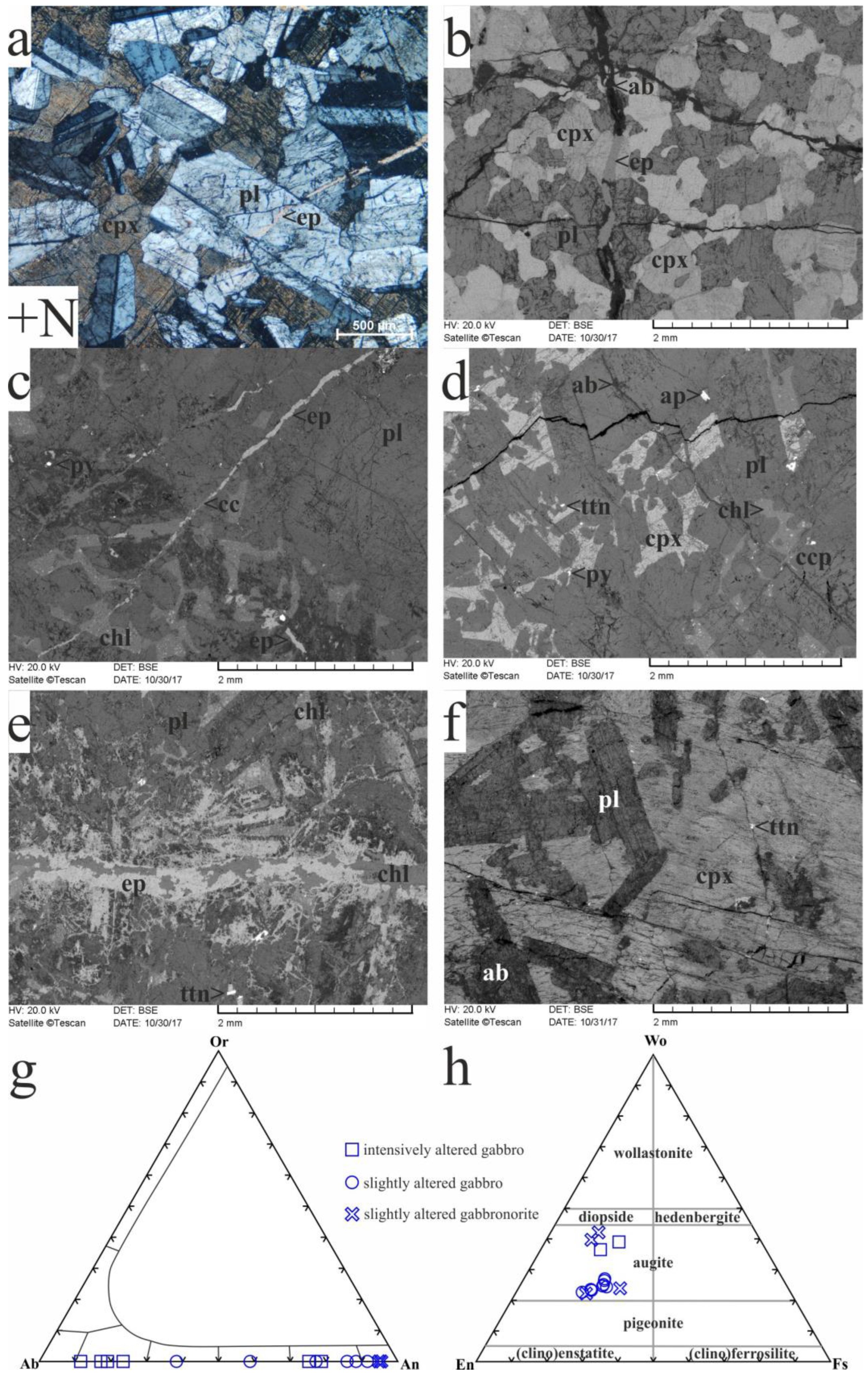
4.3. Ore Mineralisation Petrography and Mineral Chemistry
4.4. EPMA Analyses of Pyrite
4.5. Bulk Rock ICP OES Analyses
5. Discussion
5.1. Metamorphic vs. Hydrothermal Alteration of the Host Rocks
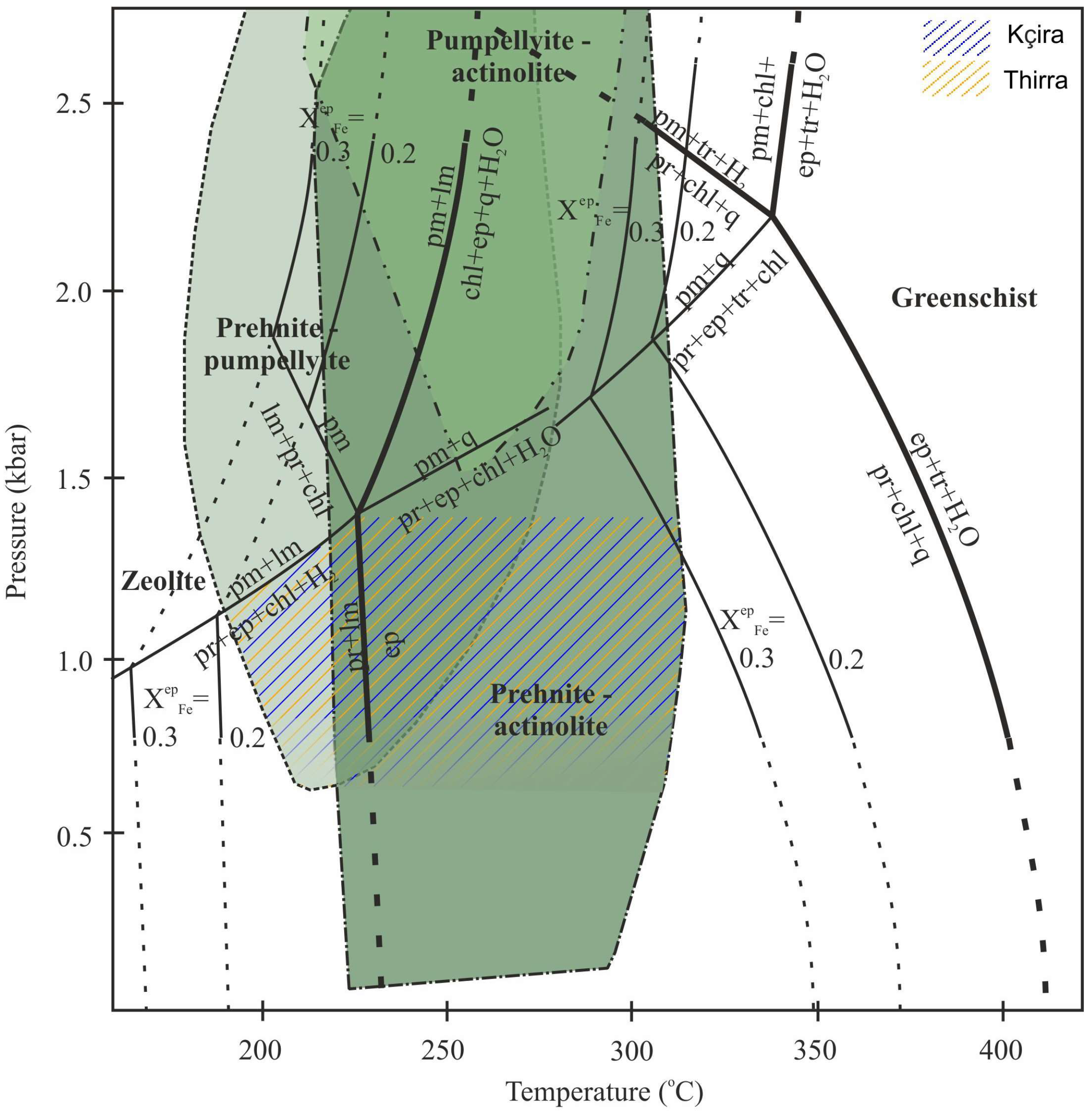
5.2. Fluid Parameters of the Ore Mineralisation and Deposit Type
6. Conclusions
- The two investigated copper deposits of the Albanian Mirdita Zone are hosted in strongly altered gabbro and gabbronorite.
- A local high-temperature hydrothermal fluid flow is indicated, as the alteration reached a higher temperature than the known metamorphism.
- The samples from the western Kçira are richer in compatible elements, while those from the eastern Thirra have higher concentrations of incompatible elements, reflecting their original geodynamic settings (MOR and SSZ, respectively).
- So far, unknown minerals have been identified in the deposits: ilvaite, scorodite, Ni- and AgAu-tellurides, native tellurium, and prehnite.
- Based on the trace element contents of the pyrite grains (Co, Ni, Te, Se) and the mineral chemical composition of the epidote, the deposits are identified as the deep stockwork feeder zones of VMS systems.
Author Contributions
Funding
Data Availability Statement
Acknowledgments
Conflicts of Interest
References
- Hoxha, L.; Scott, P.W.; Eyre, M. The geological setting of volcanogenic sulphide orebodies in Albanian ophiolites. Appl. Earth Sci. 2005, 114, 33–52. [Google Scholar] [CrossRef]
- Milushi, I.; Jata, I.; Vukzaj, N.; Gjeci, K. Exploration Complex Methods of Copper Ore in the Volcano-sedimentary Formation of Porave Area, Puka. In Proceedings of the 7th Congress of the Balkan Geophysical Society, EAGE Publications, Tirana, Albania, 7–10 October 2013. [Google Scholar] [CrossRef]
- Doda, V.; Deda, D.; Alliu, I. Sulphide mineralization in gabbro and plagiogranites in Ophiolites of Albanides. In Proceedings of the XX CBGA Congress, Tirana, Albania, 24–26 September 2014. [Google Scholar]
- Bele, S.; Kamberaj, R. The ore deposit 3D modelling, new effective solution in the optimization of geological and mining works. Earth Sci. 2017, 6, 35–43. [Google Scholar]
- Kaza, G.; Doda, V.; Naco, P.; Onuzi, K.; Gjeci, K.; Vincani, F.; Gjonaj, V. Geological-structural setting of massif and the levels of quartz-sulphide mineralization in the Kaptina Gabbro Massif. Int. J. Eng. Res. Appl. 2014, 4, 1–11. [Google Scholar]
- Dubé, B.; Gosselin, P. Greenstone-hosted quartz-carbonate vein deposits. In Mineral Deposits of Canada: A Synthesis of Major Deposit-Types, District Metallogeny, the Evolution of Geological Provinces, and Exploration Methods; Goodfellow, W.D., Ed.; Special Publication; Geological Association of Canada, Mineral Deposits Division: St. John’s, NF, Canada, 2007; pp. 49–73. [Google Scholar]
- Cox, S.F.; Etheridge, M.A.; Wall, V.J. The role of fluids in syntectonic mass transport, and the localization of metamorphic vein-type ore deposits. Ore Geol. Rev. 1986, 2, 65–86. [Google Scholar] [CrossRef]
- Hurai, V.; Lexa, O.; Schulmann, K.; Montigny, R.; Prochaska, W.; Frank, W.; Konecny, P.; Ioannou, S.E.; Spooner, E.T.C.; Barrie, C.T. Fluid temperature and salinity characteristics of the Matagami volcanogenic massive sulfide district. Quebec. Econ. Geol. 2007, 102, 691–715. [Google Scholar]
- N’diaye, I.; Essaifi, A.; Dubois, M.; Lacroix, B.; Goodenough, K.M.; Maacha, L. Fluid flow and polymetallic sulfide mineralization in the Kettara shear zone (Jebilet Massif, Variscan Belt, Morocco). J. Afr. Earth Sci. 2016, 119, 17–37. [Google Scholar] [CrossRef]
- Zaccarini, F.; Garuti, G. Mineralogy and chemical composition of VMS deposits of northern Apennine ophiolites, Italy: Evidence for the influence of country rock type on ore composition. Miner. Petrol. 2008, 94, 61–83. [Google Scholar] [CrossRef]
- Barrie, C.T.; Hannington, M.D. Introduction: Classification of VMS deposits based on host rock composition. In Volcanic-Associated Massive Sulfide Deposits: Processes and Examples in Modern and Ancient Settings; Barrie, C.T., Hannington, M.D., Eds.; Society of Economic Geology: Littleton, CO, USA, 1999; Volume 8, pp. 2–10. [Google Scholar]
- Robertson, A.H.F.; Dixon, J.E. Introduction: Aspects of the geological evolution of the Eastern Mediterranean. In The Geological Evolution of the Eastern Mediterranean; Dixon, J.E., Robertson, A.H.F., Eds.; Geological Society London Special Publication 17; Geological Society: London, UK, 1984; pp. 591–602. [Google Scholar]
- Robertson, A.H.F.; Shallo, M. Mesozoic–Tertiary tectonic evolution of Albania in its regional Eastern Mediterranean context. Tectonophysics 2000, 316, 197–254. [Google Scholar] [CrossRef]
- Zelic, M.; Agostini, S.; Marroni, M.; Pandolfi, L.; Tonarini, S. Geological and Geochemical Features Of The Kopaonik Intrusive Complex (Vardar Zone, Serbia). Ofioliti 2010, 35, 33–47. [Google Scholar]
- Hoxha, M.; Boullier, A. The peridotites of the Kukes ophiolite (Albania): Structure and kinematics. Tectonophysics 1995, 249, 217–231. [Google Scholar] [CrossRef]
- Bortolotti, V.; Kodra, A.; Marroni, M.; Mustafa, F.; Pandolfi, L.; Principi, G.; Saccani, E. Geology and petrology of ophiolitic sequences in the Mirdita region (Northern Albania). Ofioliti 1996, 21, 3–20. [Google Scholar]
- Shallo, M.; Dilek, Y. Development of the ideas on the origin of Albanian ophiolites. In Special Paper 373: Ophiolite Concept and the Evolution of Geological Thought; Geological Society of America: Boulder, CO, USA, 2003; pp. 351–363. [Google Scholar] [CrossRef]
- Dilek, Y.; Furnes, H. Structure and geochemistry of Tethyan ophiolites and their petrogenesis in subduction rollback systems. Lithos 2009, 113, 1–20. [Google Scholar] [CrossRef]
- Dimo-Lahitte, A.; Monie, P.; Vergely, P. Metamorphic soles from the Albanian ophiolites: Petrology, 40Ar/39Ar geochronology, and geodynamic evolution. Tectonics 2001, 20, 78–96. [Google Scholar] [CrossRef]
- Dilek, Y.; Furnes, H.; Shallo, M.; Mortensen, J.K. Structure, petrology, and geochronology of the Albanian ophiolites and their tectonic evolution within the Neotethyan orogenic belt, In, EUG XI, European Union of Geosciences, Strasbourg, France. J. Conf. Abstr. 2001, 6, 321. [Google Scholar]
- Dilek, Y.; Furnes, H.; Shallo, M. Geochemistry of the Jurassic Mirdita Ophiolite (Albania) and the MORB to SSZ evolution of a marginal basin oceanic crust. Lithos 2008, 100, 174–209. [Google Scholar] [CrossRef]
- Marcucci, M.; Kodra, A.; Pirdeni, A.; Gjata, T. Radiolarian assemblage in the Triassic and Jurassic cherts of Albania. Ofioliti 1994, 19, 110–114. [Google Scholar]
- Marcucci, M.; Prela, M. The Lumi i Zi (Puke) section of the Kalur Cherts: Radiolarian assemblages and comparisons with other sections in northern Albania. Ofioliti 1996, 21, 71–77. [Google Scholar]
- Robertson, A.; Ionescu, C.; Hoeck, V.; Koller, F.; Onuzi, K.; Bucur, I.; Ghega, D. Emplacement of the Jurassic Mirdita ophiolites (southern Albania): Evidence from associated clastic and carbonate sediments. Int. J. Earth Sci. 2012, 101, 1535–1558. [Google Scholar] [CrossRef]
- Cortesogno, L.; Gaggero, L.; Jaho, E.; Marroni, M.; Pandolfi, L.; Shtjefanaku, D. The gabbroic complex os the Western Ophiolitic Belt, Northern Albania: An example of multilayered sequence in an intermediete-spreading oceanic ridge. Ofioliti 1998, 2, 49–64. [Google Scholar]
- Xhomo, A.; Kodra, A.; Dimo, L.L.; Xhafa, Z.; Nazaj, S.H.; Nakuci, V.; Yizeraj, D.; Lula, F.; Sadushi, P.; Shallo, M.; et al. Geological Map of Albania, M = 1:200 000; Albanian Geological Survey: Tirana, Albania, 2002. [Google Scholar]
- Kaza, G.; Beqiraj, A.; Gjonaj, V.; Doda, V.; Ormeni, R. Structural and Mineralogical Features of the Quartz Sulphur Mineralization from the Gabbroic Massif of Kaptena (Mirdita Ophiolitic Complex of Albania). Int. J. Eng. Res. Appl. 2012, 7, 170–177. [Google Scholar]
- Morimoto, N.; Fabries, J.; Ferguson, A.K.; Ginzburg, I.V.; Ross, M.; Seifert, F.A.; Zussman, J. Nomenclature of pyroxenes. Am. Min. 1988, 73, 1123–1133. [Google Scholar]
- Deer, A.W.; Howie, R.A.; Zussman, J. Rock-Forming Minerals 4; Wiley: New York, NY, USA, 1963. [Google Scholar]
- Friedl, J.; Wagner, F.E.; Wang, N. On the chemical state of combined gold in sulfidic ores: Conclusions from Mössbauer source experiments. Neues Jahrb. Mineral. Abh. 1995, 169, 279–290. [Google Scholar]
- Seyfried, W. Experimental and theoretical constraints on hydrothermal alteration processes at mid-ocean ridges. Ann. Rev. Earth Planet. Sci. Lett 1987, 15, 317–335. [Google Scholar] [CrossRef]
- Liou, J.; Maruyama, S.; Cho, M. Phase Equilibria and mineral parageneses of metabasites in low-grade metamorphism. Mineral. Mag. 1985, 49, 321–333. [Google Scholar] [CrossRef]
- Hannington, M.D.; Santaguida, F.; Kjarsgaard, I.M.; Cathles, L.M. Regional-scale hydrothermal alteration in the Central Blake River Group, western Abitibi subprovince, Canada: Implications for VMS prospectivity. Miner. Depos. 2003, 38, 393–422. [Google Scholar] [CrossRef]
- Powell, W.G.; Carmichael, D.M.; Hodgson, C.J. Conditions and timing of metamorphism in the southern Abitibi greenstone belt, Quebec. Can. J. Earth Sci 1995, 32, 787–805. [Google Scholar] [CrossRef]
- Frey, M.; De Capitani, C.; Liou, J. A new petrogenetic grid for low-grade metabasites. J. Metam. Geol 1991, 9, 497–509. [Google Scholar] [CrossRef]
- Skoda, P. Vulkanogén Masszív Szulfid Telepek Stockwork Zónájának Fluidzárvány Vizsgálata Casali-Monte Loreto Térségében (Északi-Appenninek, Olaszország). Master’s Thesis, Eötvös Loránd University, Budapest, Hungary, 2017. [Google Scholar]
- Stakes, D.S.; O’Neil, J.R. Mineralogy and stable isotope geochemistry of hydrothermally altered oceanic rocks. Earth Planet. Sci. Lett 1982, 57, 285–304. [Google Scholar] [CrossRef]
- Alt, J.C.; Muehlenbachs, K.; Honnorez, J. An oxygen isotopic profile through the upper kilometer of the oceanic crust. DSDP Hole 504B. Earth Planet. Sci. Lett. 1986, 80, 217–229. [Google Scholar] [CrossRef]
- Delaney, J.R.; Mogk, D.M.; Mottl, M.J. Quartz-cemented breccias from the Mid-Atlantic Ridge: Samples of a high salinity upflow zone. J. Geophys. Res. 1987, 92, 9175–9192. [Google Scholar] [CrossRef]
- Gillis, K.M.; Robinson, P.T. Distribution of alteration zones in the upper oceanic crust. Geology 1988, 16, 262–266. [Google Scholar] [CrossRef]
- Bettison, L. Petrogenetic Studies of Epidotes and Mixed-Layer Chlorite/Smectite in Submarine Hydrothermal Systems. Ph.D. Thesis, University of California, Davis, CA, USA, 1991. [Google Scholar]
- Gillis, K.M.; Thompson, G. Metabasalts from the Mid-Atlantic Ridge: New insights into hydrothermal systems in slowspreading crust. Contrib. Mineral. Petrol. 1993, 113, 502–523. [Google Scholar] [CrossRef]
- Afifi, A.M.; Kelly, W.C. Phase relations among tellurides, sulfides, and oxides; Pt. II, Applications to telluride-bearing ore deposits. Econ. Geol. 1988, 83, 395–404. [Google Scholar] [CrossRef]
- Hassan, L.Y.; Roberts, M.P. Tellurides associated with volcanogenic massive sulfide (VMS) mineralization at Yuinmery and Austin, Western Australia. Ore Geol. Rev. 2017, 80, 352–362. [Google Scholar] [CrossRef]
- Ohmoto, H. Formation of volcanogenic massive sulphide deposits: The Kuroko perspective. Ore Geol. Rev. 1996, 10, 135–177. [Google Scholar] [CrossRef]
- Hannington, M.D.; de Ronde, C.E.J.; Petersen, S. Modern sea-floor tectonics and submarine hydrothermal systems. Econ. Geol. 2005, 100, 111–141. [Google Scholar]
- Bortnikov, N.S.; Genkin, A.D.; Dobrovolskaya, M.G.; Muravitskaya, G.N.; Filimonova, A.A. The nature of chalcopyrite inclusions in sphalerite: Exsolution, coprecipitation, or “disease”? Econ. Geol. 1991, 86, 1070–1082. [Google Scholar] [CrossRef]
- Bente, K.; Doering, T. Experimental studies on the solid state diffusion of Cu + In in ZnS and on “Disease”, DIS (Diffusion Induced Segregations), in sphalerite and their geological applications. Miner. Petrol. 1995, 53, 285–305. [Google Scholar] [CrossRef]
- Ramdohr, P.; Cobaltite. The Ore Minerals and their Intergrowths; Ramdohr, P., Ed.; Pergamon Press: Braunschweig, Germany, 1969; pp. 814–820. [Google Scholar]
- Klein, C. Manual of Mineralogy, 22nd ed.; John Wiley & Sons Inc.: Hoboken, NJ, USA, 2002; pp. 333–370. [Google Scholar]
- Haldar, S.K. Platinum-Nickel-Chromium Deposits; Elsevier: Amsterdam, The Netherlands, 2017; pp. 1–34. [Google Scholar]
- Noll, P.D.; Newsom, H.E.; Leeman, W.P.; Ryan, J.G. The role of hydrothermal fluids in the production of subduction zone magmas: Evidence from siderophile and chalcophile trace elements and boron. Geochim. Cosmochim. Acta 1996, 60, 587–611. [Google Scholar] [CrossRef]
- Abraitis, P.K.; Pattrick, R.A.D.; Vaughan, D.J. Variations in the compositional, textural and electrical properties of natural pyrite: A review. Int. J. Miner. Process. 2004, 74, 41–59. [Google Scholar] [CrossRef]
- Reich, M.; Deditius, A.; Chryssoulis, S.; Li, J.-W.; Ma, C.-Q.; Parada, F.; Barra, P.F.; Mittermayr, F. Pyrite as a record of hydrothermal fluid evolution in a porphyry copper system: A SIMS/EMPA trace element study. Geochim. Cosmochim. Acta 2013, 104, 42–62. [Google Scholar] [CrossRef]
- Genna, D.; Gaboury, D. Deciphering the hydrothermal evolution of a VMS System by LA-ICP-MS using trace elements in pyrite: An example from the Bracemac- McLeod Deposits, Abitibi, Canada, and implications for exploration. Econ. Geol. 2015, 110, 2087–2108. [Google Scholar] [CrossRef]
- Carstens, C.W. Om geokjemiske undersøkelser av malmer. Norsk Geol. Tidsskr. 1941, 21, 213–221. [Google Scholar]
- Hegemann, F. Die geochemische Bedeutung von Kobalt und Nickel im Pyrit. Z. Angew. Mineral. 1943, 4, 122–239. [Google Scholar]
- Hegemann, F. Die geochemisehe Bedeutung Von Kobalt und Nikel in Pyrit. Z. Angew Mineral. 1943, 4, 2–3. [Google Scholar]
- Gavelin, S.; Gabrielson, O. Spectrochemical investigation of sulphide minerals from the ores of the Skellefte district. Sveriges Geologiska Undersökning 1947, 41, 1–45. [Google Scholar]
- Hawley, J.E.; Nichol, I. Trace elements in pyrite, pyrrhotite and chalcopyrite of different ores. Econ. Geol. 1961, 56, 467–487. [Google Scholar] [CrossRef]
- Bralia, A.; Sabatini, G.; Troja, F. A revaluation of the Co/Ni ratio in pyrite: A geochemical tool in ore genesis problems. Miner. Depos. 1979, 14, 353–374. [Google Scholar] [CrossRef]
- Mookherjee, A.; Philip, R. Distribution of copper, cobalt and nickel in ores and host-rocks, Ingladhal, Karnataka, India. Miner. Depos. 1979, 14, 33–55. [Google Scholar] [CrossRef]
- Keith, M.; Haase, K.M.; Klemd, R.; Kruss, S.; Strauss, H. Systematic variations of trace element and sulfur isotope compositions in pyrite with stratigraphic depth in the Skouriotissa volcanic-hosted massive sulfide deposit, Troodos ophiolite, Cyprus. Chem. Geol. 2016, 423, 7–18. [Google Scholar] [CrossRef]
- Bajwah, Z.U.; Seccombe, P.K.; Offler, R. Trace element distribution, Co: Ni ratios and genesis of the Big Cadia iron-coper deposit, New South Wales, Australia. Miner. Depos. 1987, 22, 292–300. [Google Scholar] [CrossRef]
- Song, X. Minor Elements and Ore Genesis of the Fankou Lead-Zinc Deposit, China. Miner. Depos. 1984, 19, 95–104. [Google Scholar]
- Huston, D.L.; Sie, S.H.; Suter, G.F.; Cook, D.R.; Both, R.A. Trace Elements in Sulfide Minerals from Eastern Australian Volcanic-Hosted Massive Sulfide Deposits Part I. Proton Microprobe analyses of Pyrite, Chalcopyrite and Sphalerite and Part II. Selenium Levels in Pyrite: Comparison with δ34S values and Implications for the Source of Sulfur in Volcanogenic hydrothermal Systems. Econ. Geol. 1995, 90, 1167–1196. [Google Scholar]
- Keith, M.; Häckel, F.; Haase, K.M.; Schwarz-Schampera, U.; Klemd, R. Trace element systematics of pyrite from submarine hydrothermal vents. Ore Geol. Rev. 2016, 72, 728–745. [Google Scholar] [CrossRef]
- Levinson, A.A. Introduction to Exploration Geochemistry; Applied Publishing Ltd.: Calgary, AB, Canada, 1974; p. 612. [Google Scholar]
- Lydon, J.W. Volcanogenic massive sulfide deposits, Part 2: Genetic models. Geosci. Can. 1988, 15, 155–181. [Google Scholar]
- Large, R.R. Australian volcanic-hosted massive sulfide deposits: Features, styles and genetic models. Econ Geol. 1992, 87, 471–510. [Google Scholar] [CrossRef]
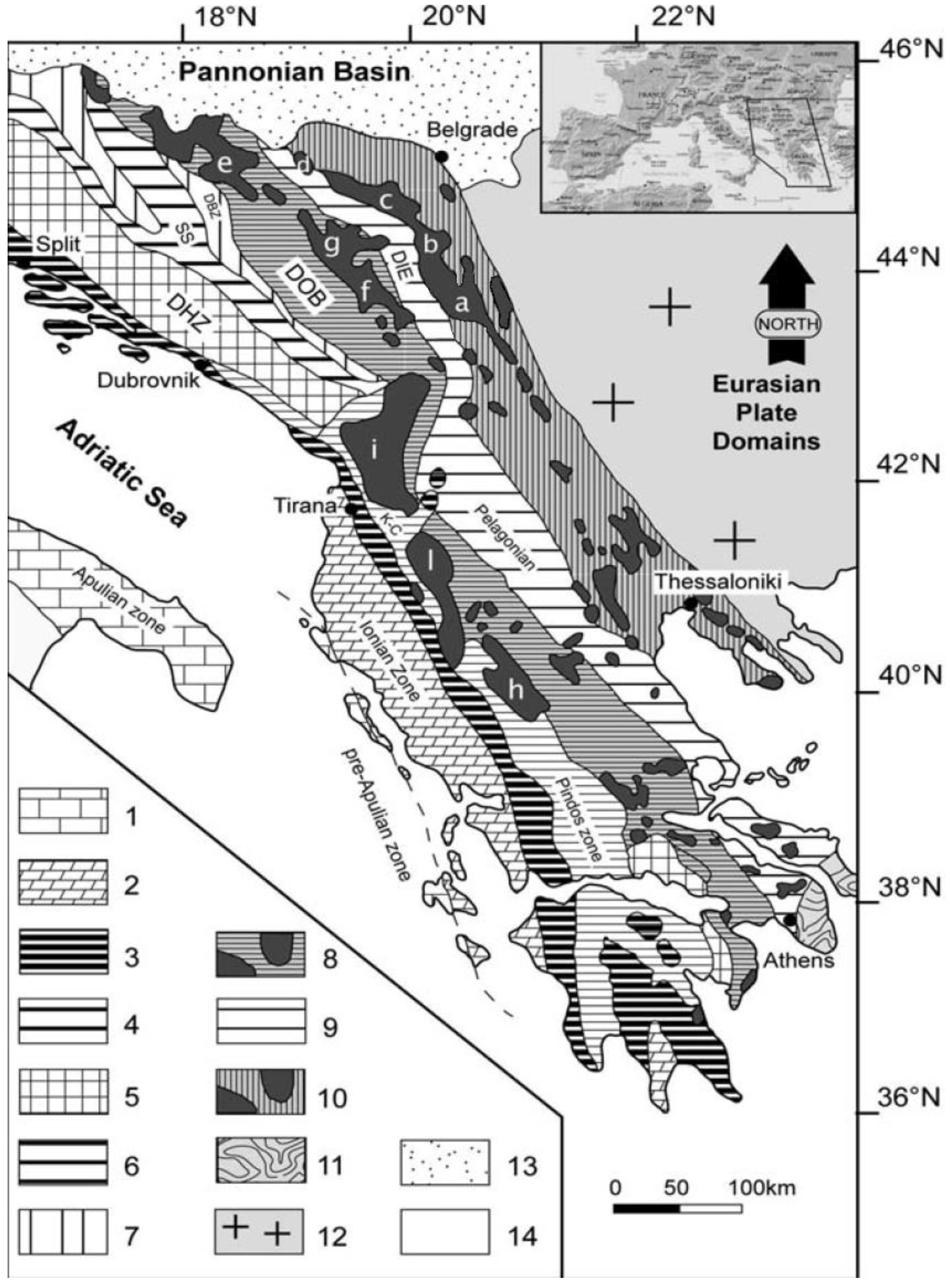
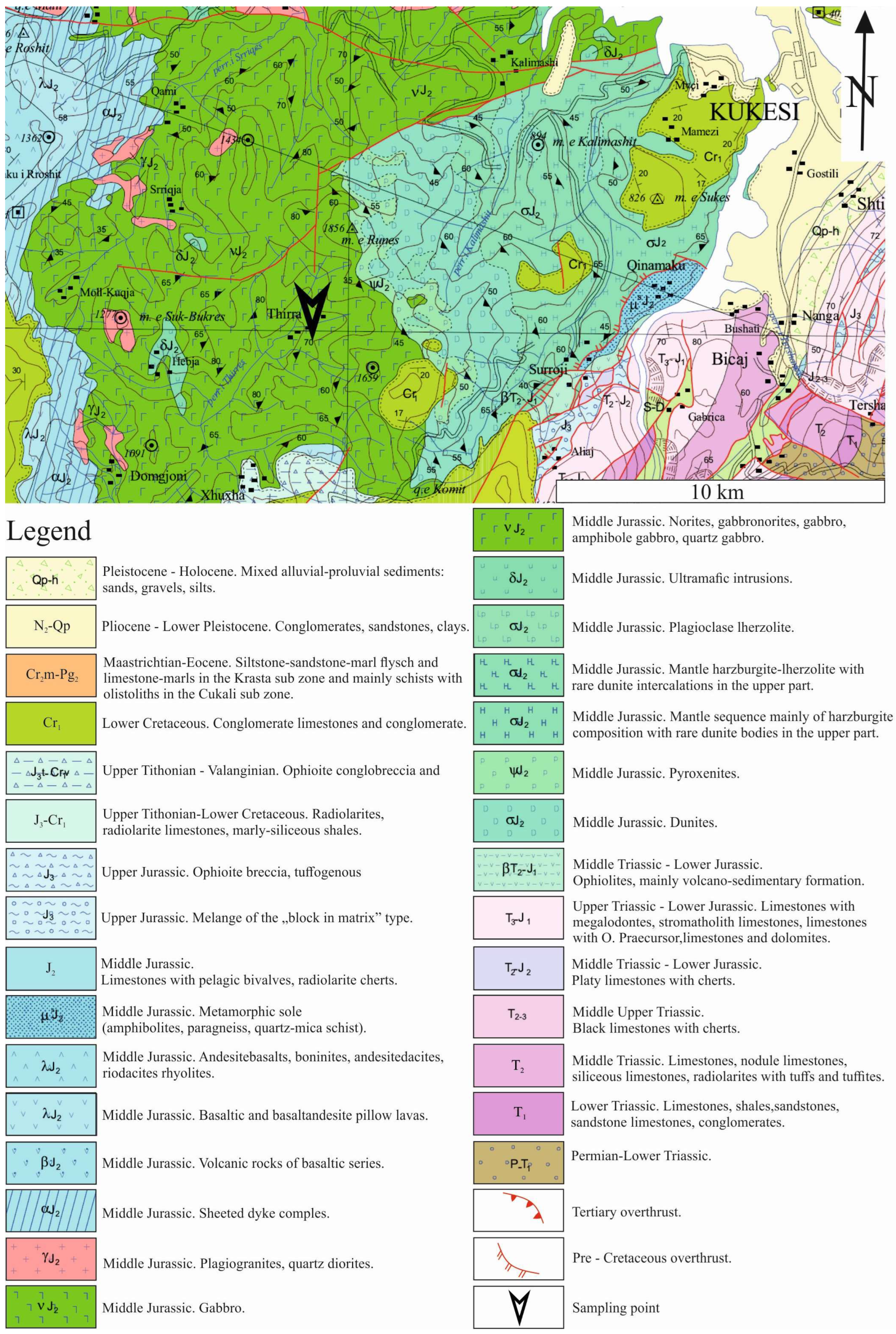

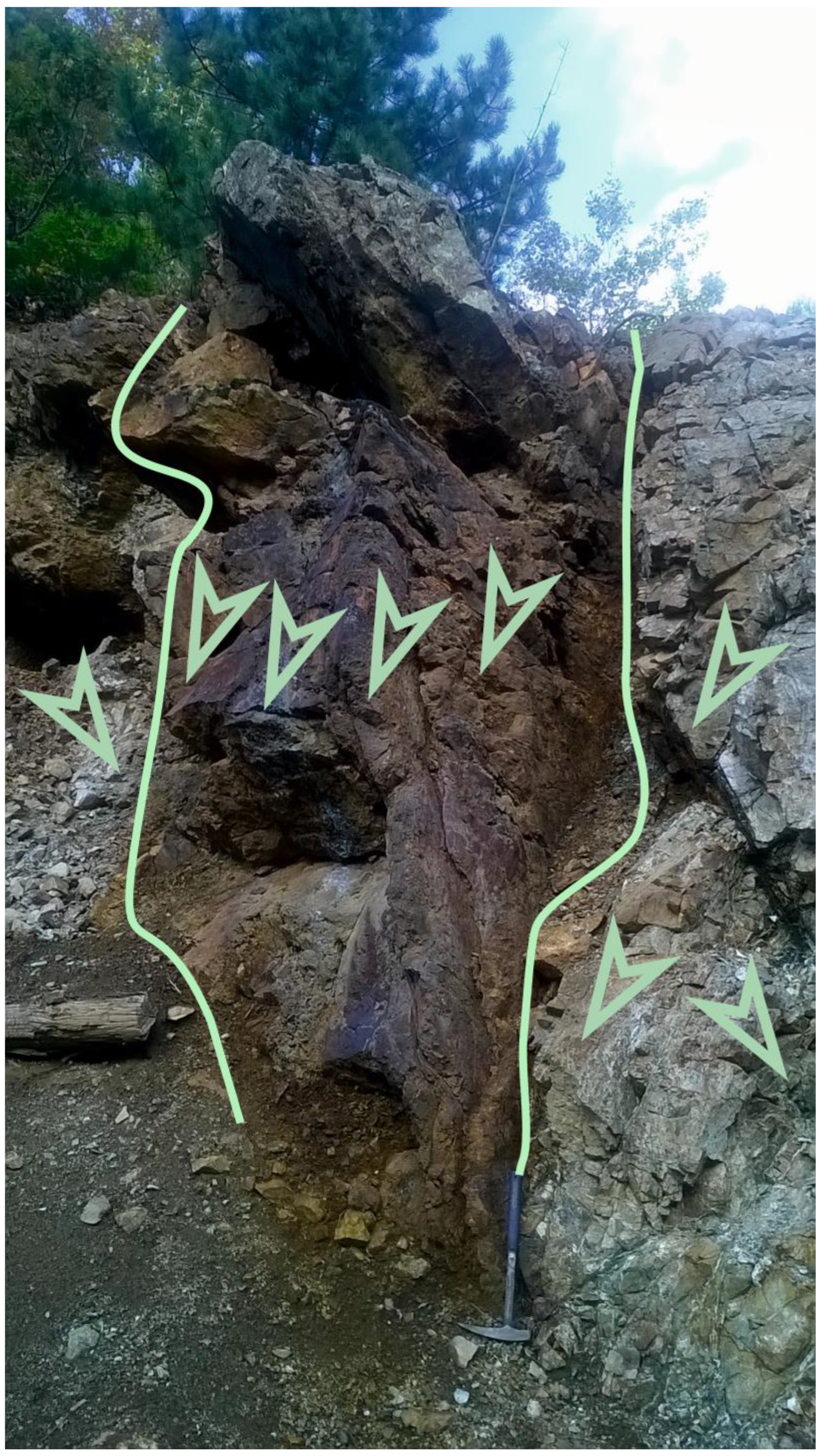
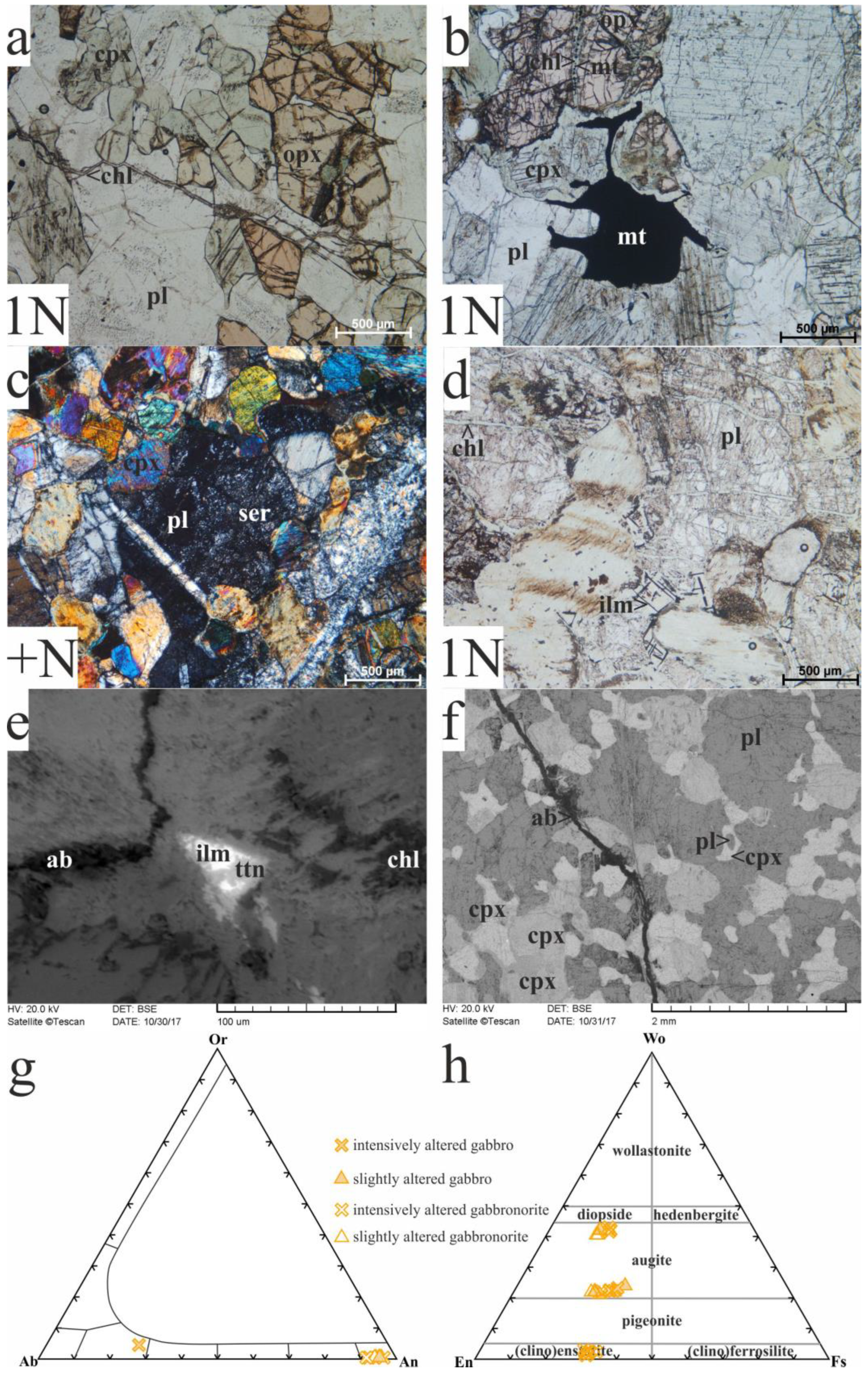
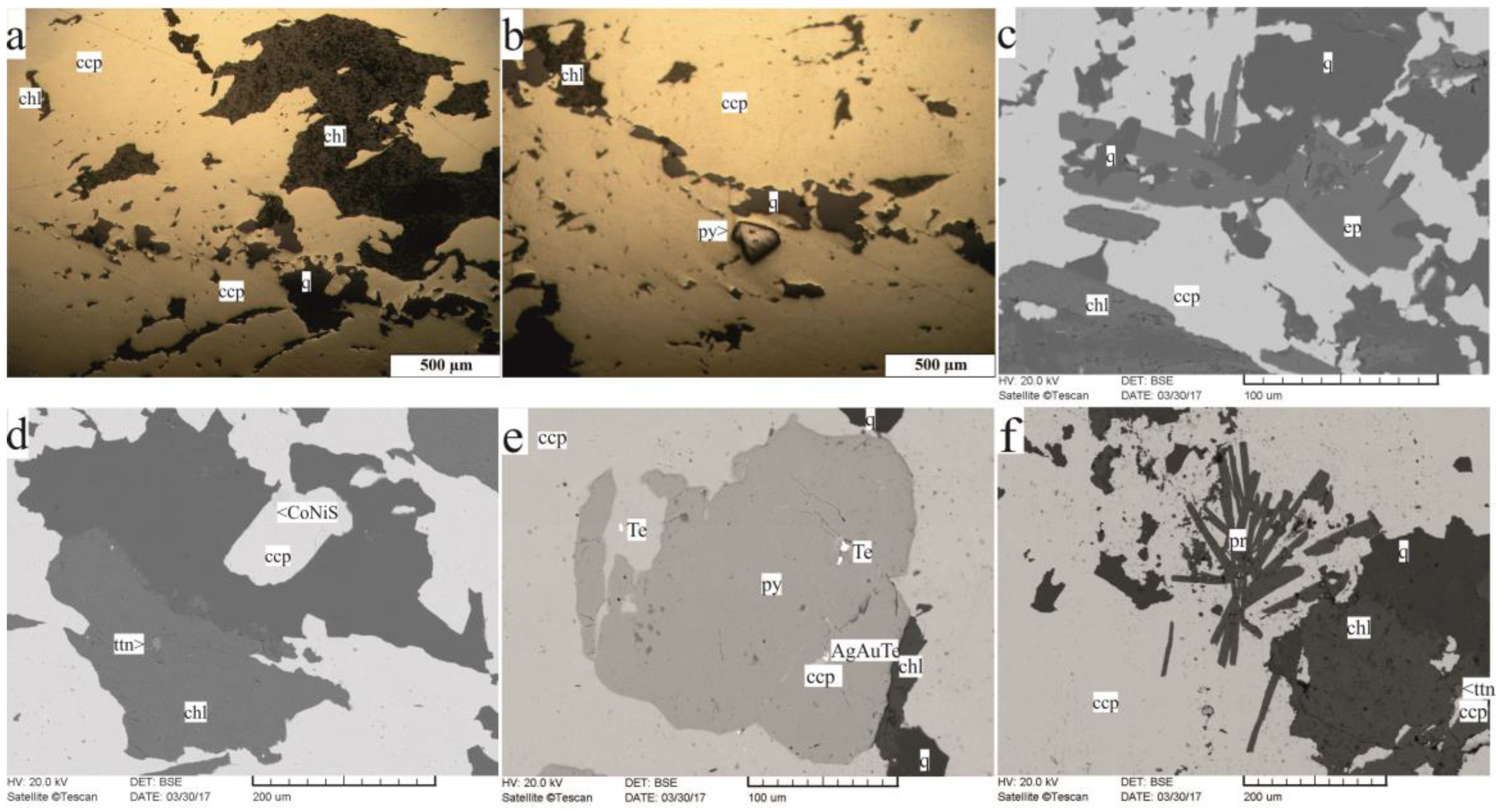

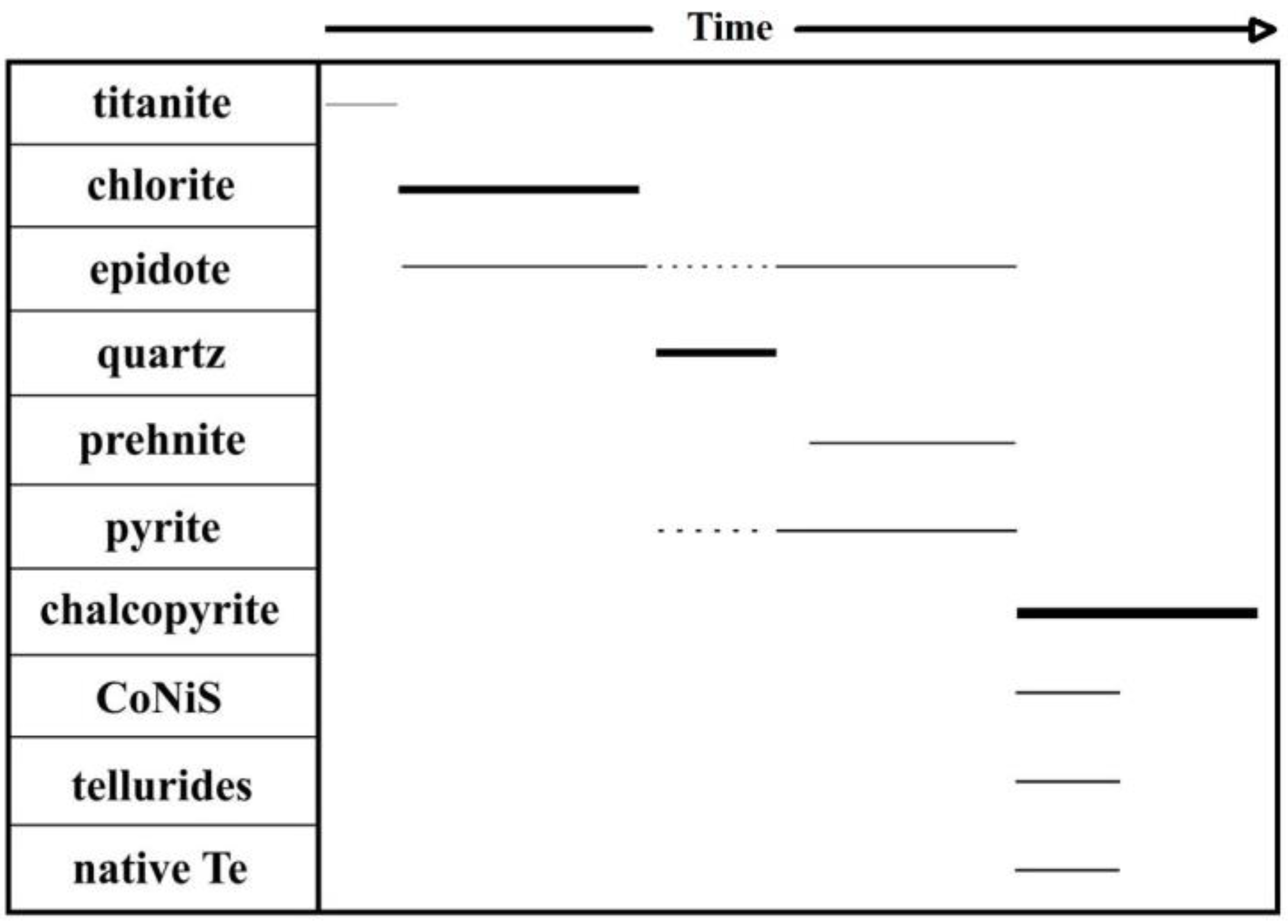
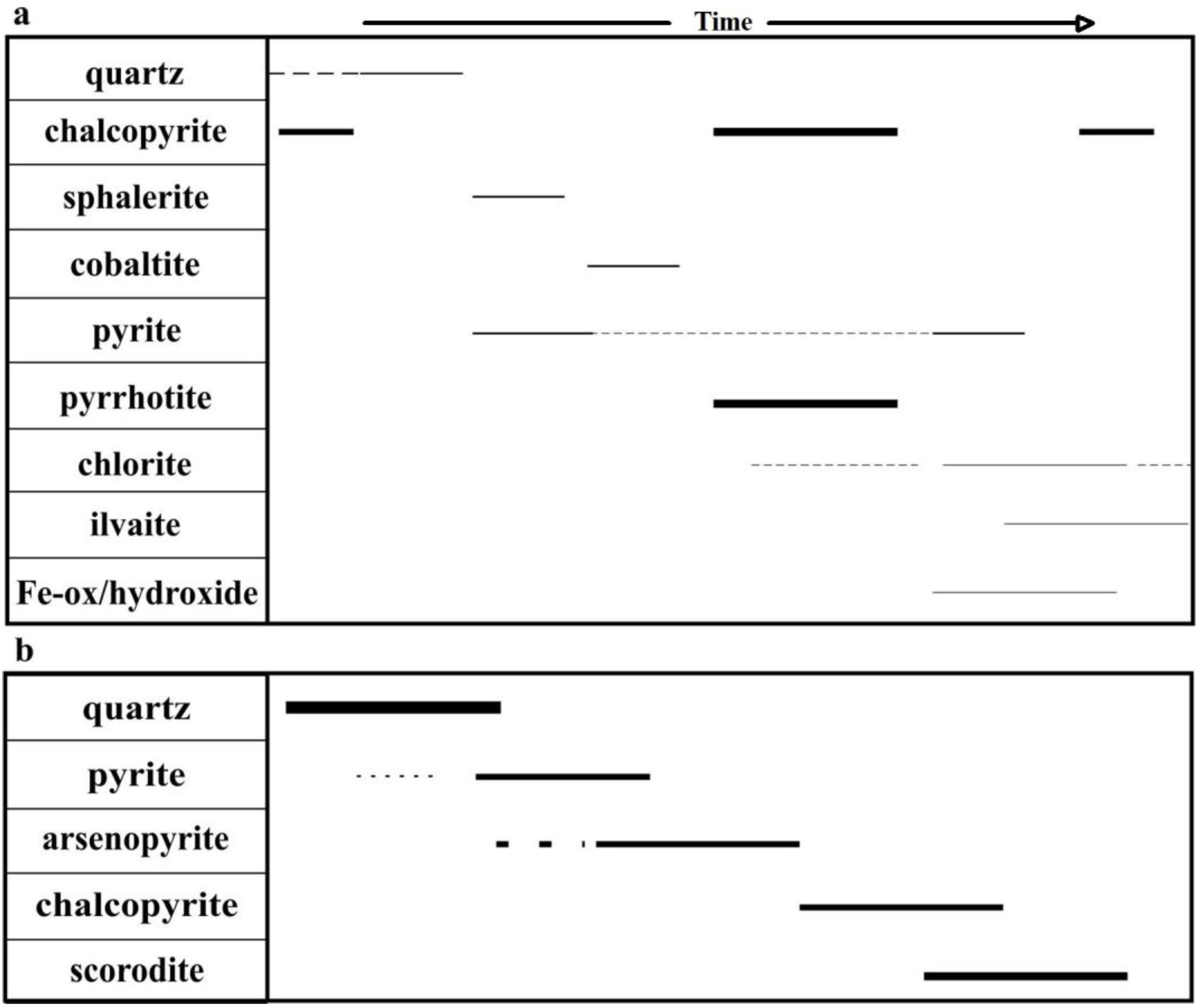
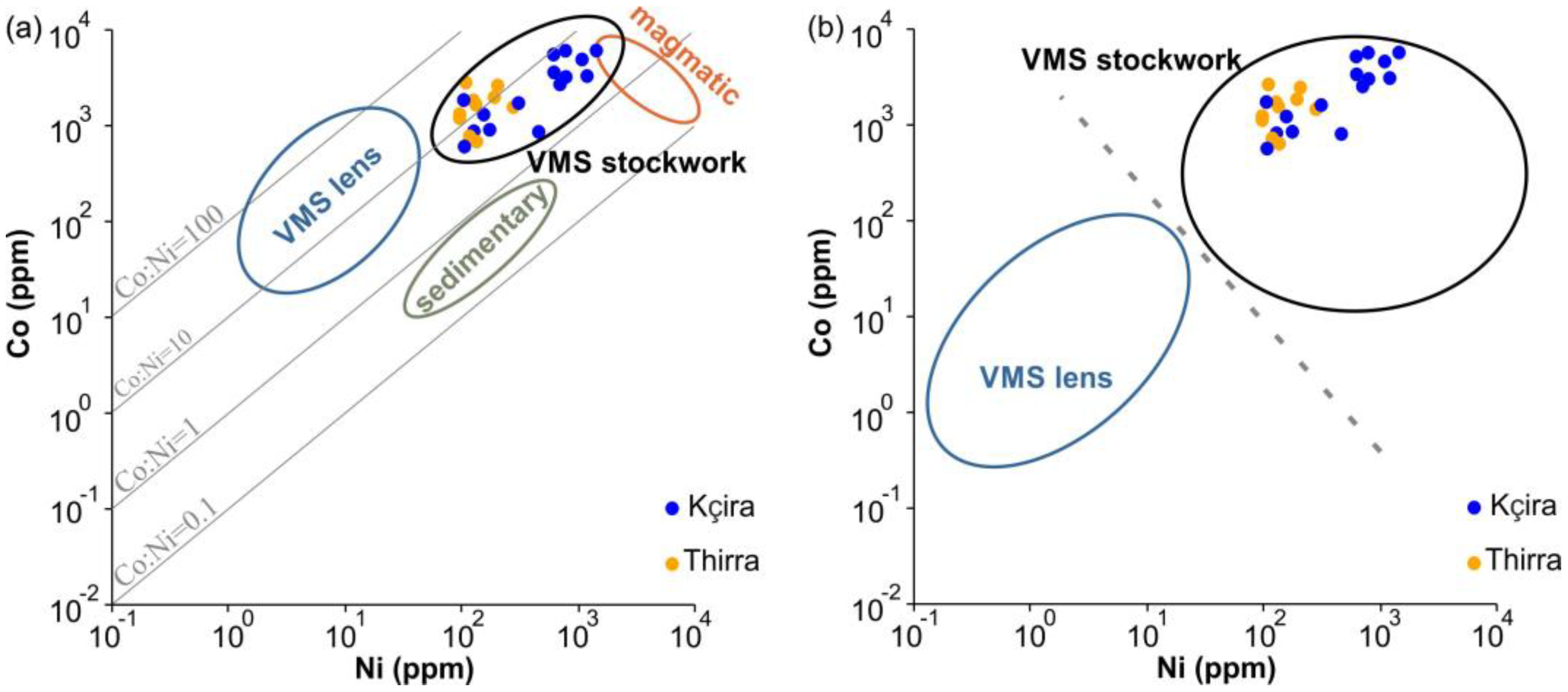

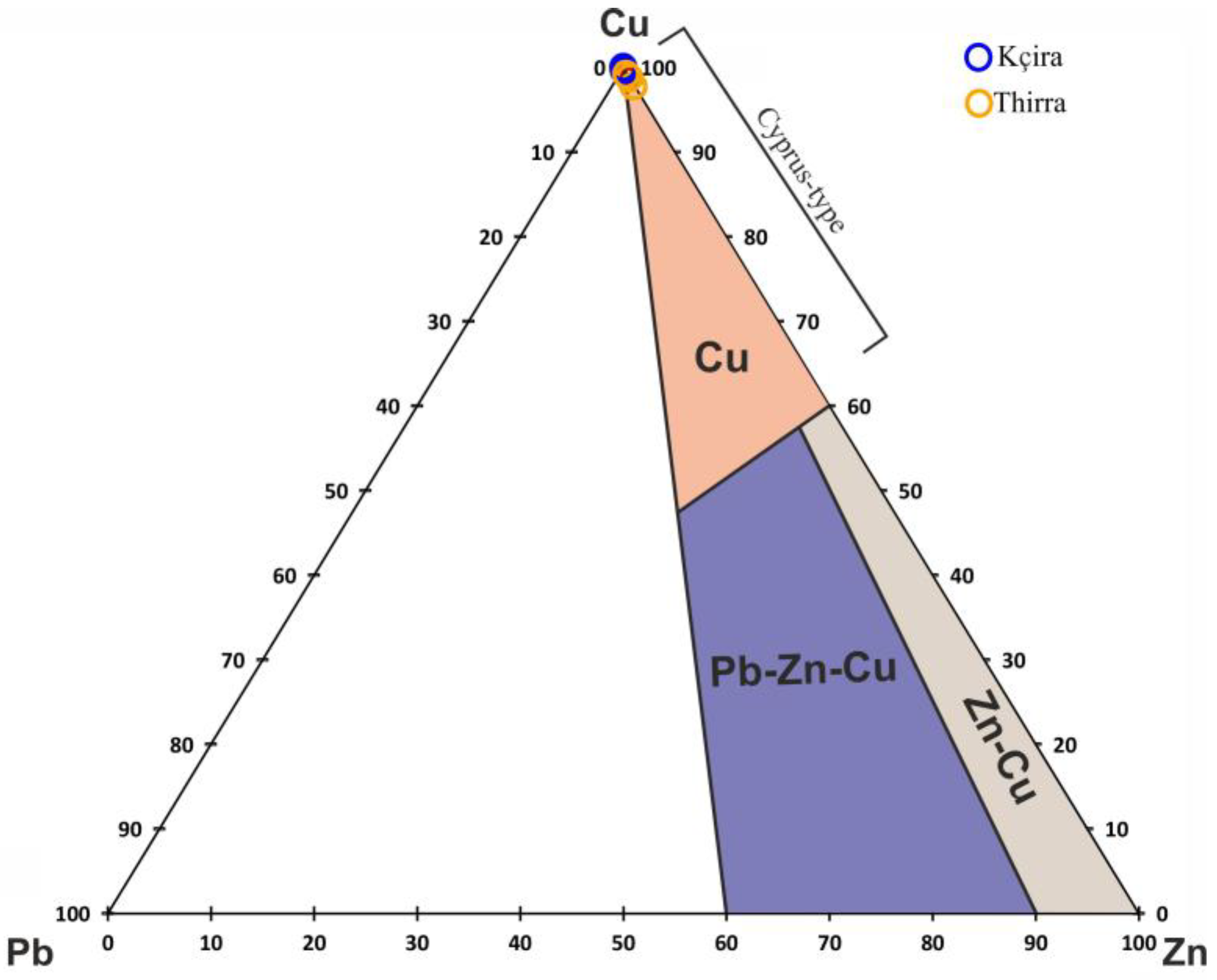
| Locality | Rock Type | n | SiO2 | Al2O3 | Fe2O3 * | CaO | Total | Si | Al | Fe | Ca | Total | Fe # |
|---|---|---|---|---|---|---|---|---|---|---|---|---|---|
| Puka | altered host | 5 | 39.49 ± 0.61 | 26.75 ± 0.60 | 7.98 ± 0.77 | 23.78 ± 0.24 | 98 | 6.14 ± 0.08 | 4.90 ± 0.10 | 0.93 ± 0.09 | 3.96 ± 0.05 | 15.94 ± 0.04 | 0.16 ± 0.02 |
| altered host | 17 | 38.40 ± 0.58 | 25.38 ± 1.32 | 10.51 ± 1.92 | 23.70 ± 0.56 | 98 | 6.04 ± 0.06 | 4.70 ± 0.21 | 1.25 ± 0.23 | 3.99 ± 0.10 | 15.99 ± 0.05 | 0.21 ± 0.04 | |
| mineralised vein | 4 | 39.32 ± 0.16 | 24.20 ± 1.30 | 10.48 ± 1.46 | 24.00 ± 0.25 | 98 | 6.19 ± 0.04 | 4.48 ± 0.22 | 1.24 ± 0.18 | 3.99 ± 0.03 | 15.94 ± 0.02 | 0.22 ± 0.03 | |
| Thirra | altered host | 5 | 39.05 ± 1.12 | 24.62 ± 1.06 | 10.52 ± 1.35 | 23.81 ± 1.20 | 98 | 6.14 ± 0.13 | 4.56 ± 0.18 | 1.24 ± 0.16 | 4.01 ± 0.22 | 15.96 ± 0.03 | 0.21 ± 0.03 |
| Fe | S | Cu | Zn | Pb | Bi | As | Se | Co | Ni | Te | Ag | Au | Tl | Total | |
|---|---|---|---|---|---|---|---|---|---|---|---|---|---|---|---|
| d.l. (ppm) | 150 | 150 | 500 | 200 | 400 | 400 | 300 | 300 | 200 | 100 | 150 | 300 | 500 | 500 | |
| Thirra | 47.27 | 53.14 | - | 320 | - | - | - | - | 1040 | - | - | - | - | - | 100.61 |
| 47.51 | 53.29 | - | - | - | - | - | - | 1060 | - | - | - | 680 | - | 101.03 | |
| 47.27 | 53.15 | - | - | - | - | - | - | 830 | - | - | 320 | - | - | 100.60 | |
| 47.57 | 53.36 | - | - | - | - | - | - | 1410 | - | - | - | - | - | 101.11 | |
| 47.66 | 52.80 | - | - | - | - | - | 310 | 460 | - | - | - | - | - | 100.58 | |
| 47.78 | 53.35 | 830 | - | 770 | - | - | - | - | - | - | - | - | - | 101.34 | |
| 47.36 | 52.69 | - | - | - | - | - | 300 | 1410 | - | - | - | - | - | 100.21 | |
| 47.39 | 53.20 | - | - | - | - | - | - | 1320 | - | - | - | - | - | 100.81 | |
| 46.48 | 53.23 | 720 | - | - | - | - | 1270 | 1090 | - | - | 340 | - | - | 100.10 | |
| 47.39 | 52.68 | 950 | - | - | - | - | - | 640 | - | - | 300 | - | 1000 | 100.36 | |
| 46.79 | 52.73 | - | 230 | - | - | - | - | 900 | - | - | 800 | - | - | 99.75 | |
| 46.91 | 52.65 | - | - | - | - | - | - | 2990 | - | 200 | - | - | - | 99.89 | |
| 47.31 | 52.40 | - | - | - | 460 | 800 | 440 | 890 | - | 230 | - | 1170 | - | 100.13 | |
| 46.99 | 52.39 | 1380 | - | - | - | 380 | 600 | 880 | - | 150 | - | - | - | 99.76 | |
| 46.94 | 52.61 | 1040 | - | - | - | - | - | 1440 | - | - | - | - | - | 99.82 | |
| 46.30 | 53.04 | 2930 | - | - | - | 470 | 740 | 2600 | - | - | - | 1510 | - | 100.17 | |
| 47.28 | 52.36 | - | - | - | - | - | - | 1570 | - | - | - | - | - | 99.87 | |
| 46.54 | 53.27 | - | - | - | - | - | - | 1180 | - | 250 | - | - | - | 99.97 | |
| 47.24 | 52.80 | - | - | - | - | - | 2500 | 2300 | - | - | - | - | - | 100.55 | |
| 47.50 | 52.74 | - | - | - | - | - | 470 | 1240 | - | 190 | - | - | - | 100.45 | |
| 47.64 | 53.01 | - | - | - | - | - | - | 300 | - | - | - | - | - | 100.71 | |
| 46.93 | 53.43 | - | - | - | - | - | 1100 | 520 | - | - | - | - | - | 100.53 | |
| 47.02 | 52.75 | - | - | 770 | - | 1000 | 700 | 1310 | - | - | 490 | - | - | 100.20 | |
| 47.02 | 53.40 | 780 | - | - | - | 710 | - | 850 | - | - | - | - | - | 100.71 | |
| 46.92 | 53.01 | - | - | - | - | - | - | 1190 | - | - | - | 780 | - | 100.21 | |
| 47.33 | 53.14 | 620 | - | - | - | 610 | - | 820 | - | - | - | 530 | - | 100.75 | |
| 46.81 | 52.54 | 1480 | - | - | - | - | - | 1560 | - | - | - | - | - | 99.66 | |
| 46.41 | 52.81 | - | - | - | - | 520 | - | 1280 | - | - | - | - | - | 99.45 | |
| 46.25 | 52.73 | 4660 | - | - | - | - | 710 | 910 | - | - | - | - | - | 99.61 | |
| 46.19 | 52.92 | 5360 | - | - | - | - | 510 | 520 | - | 190 | - | - | - | 99.82 | |
| 46.14 | 52.30 | 6050 | - | - | - | - | - | 680 | - | - | - | - | - | 99.14 | |
| 47.08 | 52.84 | - | - | - | - | 400 | - | 500 | - | - | - | - | - | 100.01 | |
| 47.03 | 52.95 | - | - | - | - | - | 740 | 880 | - | 390 | - | - | - | 100.25 | |
| 46.35 | 52.77 | 2430 | - | - | - | - | - | 1530 | - | - | - | - | - | 99.53 | |
| 46.83 | 52.87 | - | - | 490 | - | - | - | 540 | - | - | - | - | - | 99.80 | |
| 46.49 | 53.05 | 1300 | - | - | - | 670 | 950 | 770 | - | 260 | 760 | - | - | 100.04 | |
| 46.32 | 52.98 | 540 | - | 410 | - | - | 1110 | 720 | - | - | - | - | - | 99.60 | |
| 46.60 | 52.85 | 1080 | - | - | - | - | 1060 | 610 | - | - | - | - | - | 99.76 | |
| 46.87 | 52.87 | 1980 | - | - | - | - | - | 1330 | 100 | - | - | - | - | 100.15 | |
| 46.85 | 52.86 | 510 | - | - | - | - | - | 1120 | - | - | - | - | - | 99.93 | |
| 47.61 | 53.06 | - | - | - | - | - | 560 | 450 | - | - | - | - | - | 100.87 | |
| 46.94 | 52.98 | - | - | - | - | 430 | 430 | 760 | 120 | - | - | - | - | 100.11 | |
| 46.32 | 53.64 | - | - | - | - | 380 | - | 410 | - | 170 | 340 | - | - | 100.09 | |
| 46.25 | 52.70 | - | - | - | - | 1140 | - | 570 | - | - | - | - | - | 99.17 | |
| 46.07 | 52.90 | - | - | - | - | 400 | - | - | - | - | - | 730 | - | 99.14 | |
| 46.61 | 53.55 | 1190 | - | - | - | - | - | 1470 | - | - | 400 | - | - | 100.50 | |
| 47.52 | 52.75 | 4800 | 250 | - | - | - | - | 2340 | - | - | - | - | - | 101.05 | |
| 46.72 | 52.57 | 2550 | - | - | - | - | - | 1190 | 100 | - | - | - | - | 99.69 | |
| 46.27 | 53.59 | - | - | - | - | - | - | 950 | - | - | - | - | - | 99.97 | |
| 46.41 | 53.53 | - | - | - | - | 310 | - | 600 | - | - | - | 670 | - | 100.13 | |
| 46.34 | 53.02 | - | - | 620 | - | 500 | - | 520 | - | - | - | 770 | - | 99.63 | |
| 46.72 | 53.48 | 530 | - | - | - | 440 | 820 | - | - | - | - | - | - | 100.41 | |
| 46.78 | 52.69 | 510 | - | - | - | 440 | 970 | 820 | - | - | - | 920 | - | 99.85 | |
| 47.05 | 52.47 | 510 | - | 870 | - | - | 2420 | 2510 | - | - | - | 720 | - | 100.25 | |
| 46.99 | 53.08 | 570 | - | 700 | - | - | - | 1440 | - | - | - | 580 | - | 100.41 | |
| 46.87 | 52.47 | - | - | - | - | - | 2860 | 2140 | - | 390 | 350 | - | - | 99.97 | |
| 46.22 | 52.99 | - | - | - | - | - | - | 1670 | - | - | - | - | - | 99.40 | |
| 46.83 | 52.79 | - | - | 1190 | - | 1010 | 2290 | 2570 | 210 | - | - | - | - | 100.38 | |
| 46.48 | 52.97 | - | - | - | - | 300 | 2050 | 1830 | 130 | - | - | - | - | 99.88 | |
| 46.51 | 52.91 | - | - | - | - | 1110 | 2030 | 2780 | 110 | 230 | - | 770 | - | 100.13 | |
| 46.69 | 52.40 | - | - | - | - | 510 | 1720 | 1230 | - | - | - | - | - | 99.46 | |
| 46.84 | 52.95 | 550 | - | - | - | - | - | 840 | - | - | - | - | - | 99.93 | |
| 46.45 | 52.76 | - | - | - | - | - | 370 | 1790 | - | - | - | - | - | 99.44 | |
| 46.61 | 52.70 | 1100 | - | 490 | - | - | 1510 | 1980 | 200 | - | 310 | - | - | 99.88 | |
| 46.08 | 52.99 | - | - | - | 480 | - | 680 | 1570 | 290 | - | 670 | - | - | 99.49 | |
| 46.73 | 53.36 | 1540 | - | - | - | 300 | 3450 | 1640 | 140 | - | - | - | - | 100.85 | |
| 46.02 | 52.81 | - | - | - | - | 490 | - | 1830 | - | - | - | - | - | 99.08 | |
| 47.10 | 52.92 | - | - | - | - | 340 | 790 | 990 | - | - | - | - | - | 100.29 | |
| 46.28 | 52.91 | 930 | - | 590 | - | - | 1390 | 1310 | - | - | 370 | 720 | - | 99.73 | |
| 46.70 | 52.64 | 2390 | - | - | - | - | 440 | 1220 | - | 230 | - | 720 | - | 99.87 | |
| 46.63 | 52.90 | 3270 | - | - | - | - | 1500 | 670 | 140 | - | 370 | - | - | 100.13 | |
| 46.84 | 53.17 | 3170 | - | 480 | - | 680 | 740 | 1120 | - | - | 400 | - | - | 100.67 | |
| 46.81 | 52.60 | - | - | - | - | - | 970 | 1570 | - | - | - | - | - | 99.72 | |
| 46.83 | 52.53 | - | - | - | - | - | 1770 | 2090 | - | - | - | - | - | 99.81 | |
| 46.75 | 52.86 | - | - | - | - | - | 320 | 1850 | - | - | - | 860 | 810 | 100.04 | |
| 46.44 | 52.92 | - | - | - | - | - | 750 | 1820 | - | 200 | - | - | - | 99.69 | |
| 46.71 | 52.62 | - | - | - | - | 310 | - | 1950 | - | - | - | - | - | 99.56 | |
| 46.19 | 52.99 | - | - | - | - | 620 | 1920 | 2470 | - | - | - | - | - | 99.69 | |
| 46.25 | 52.93 | - | - | - | - | - | 660 | 1780 | - | - | - | - | - | 99.44 | |
| 46.56 | 52.71 | - | - | - | - | 700 | 1990 | 1560 | - | - | 450 | - | - | 99.73 | |
| Kcira | 46.71 | 53.32 | - | - | - | - | - | - | 5920 | 1400 | 490 | - | - | - | 100.87 |
| 46.36 | 53.20 | - | - | - | - | 680 | - | 4730 | 1100 | - | - | - | - | 100.22 | |
| 46.70 | 53.10 | - | - | - | - | - | 600 | 5310 | 640 | - | - | - | - | 100.48 | |
| 45.86 | 52.46 | - | - | 1180 | - | - | 960 | 5920 | 780 | - | - | - | - | 99.22 | |
| 46.97 | 52.92 | - | - | 590 | - | - | - | 3140 | 800 | 180 | - | - | - | 100.37 | |
| 46.38 | 52.72 | 1050 | - | - | - | - | 410 | 2660 | 720 | 270 | - | 520 | - | 99.67 | |
| 46.34 | 52.93 | 3060 | - | - | - | - | 570 | 3530 | 640 | - | - | - | - | 100.05 | |
| 46.08 | 52.92 | 4700 | - | - | - | - | 740 | 3140 | 1220 | - | - | - | - | 99.99 | |
| 47.40 | 52.98 | 810 | - | - | - | 1280 | 300 | 730 | - | 550 | - | - | - | 100.80 | |
| 46.31 | 53.12 | 1190 | - | - | - | - | - | 570 | - | - | - | 860 | - | 99.73 | |
| 46.31 | 52.85 | 3990 | - | - | - | - | - | 2020 | - | - | - | - | - | 99.80 | |
| 46.64 | 52.69 | 2420 | - | - | - | - | - | 890 | 180 | - | - | - | - | 99.73 | |
| 46.42 | 53.03 | 3350 | 220 | 540 | - | 1170 | - | 1880 | - | - | - | - | - | 100.18 | |
| 46.75 | 53.24 | 4200 | 300 | - | - | - | 570 | 1590 | - | - | - | - | - | 100.68 | |
| 47.70 | 52.82 | 5010 | - | - | - | - | 510 | 1810 | 110 | - | 600 | - | - | 101.34 | |
| 46.29 | 52.23 | 13290 | - | - | - | 3450 | - | 590 | 110 | - | - | - | - | 100.28 | |
| 46.15 | 52.39 | 3220 | - | - | - | 1760 | 520 | 1290 | 160 | 180 | - | - | - | 99.27 | |
| 46.05 | 52.69 | 2970 | - | - | - | 2410 | 470 | 950 | - | - | - | - | - | 99.44 | |
| 46.22 | 52.52 | 3730 | - | - | - | 2210 | - | 1650 | 310 | - | - | - | - | 99.54 | |
| 46.05 | 52.77 | 3530 | - | - | - | 1840 | 760 | 1280 | - | 220 | - | - | - | 99.59 | |
| 46.02 | 53.13 | 3550 | - | - | - | 4060 | - | 1470 | - | - | - | - | - | 100.07 | |
| 46.05 | 52.76 | 6570 | - | - | - | 4540 | - | 1330 | - | - | - | - | - | 100.10 | |
| 46.22 | 52.94 | 7740 | - | 1150 | - | 3110 | - | 1210 | - | - | - | - | - | 100.55 | |
| 45.51 | 52.61 | 9360 | - | - | - | 4450 | - | 1090 | - | - | - | - | - | 99.62 | |
| 46.14 | 52.96 | 6650 | - | - | - | 2650 | 670 | 830 | 470 | - | - | - | - | 100.23 | |
| 46.34 | 52.77 | 8230 | - | - | - | 2130 | 650 | 1380 | - | - | - | - | - | 100.35 | |
| 46.46 | 53.21 | 4280 | - | - | - | - | 500 | 810 | 130 | - | - | - | - | 100.28 | |
| 46.14 | 52.95 | 5380 | - | - | - | - | - | 940 | - | - | 430 | 950 | - | 99.89 |
| As | Ag | Zn | Cu | Co | V | Cr | Ni | |
|---|---|---|---|---|---|---|---|---|
| d.l. (ppm) | ppm | ppm | ppm | wt% | ppm | ppm | ppm | ppm |
| 50 | 10 | 25 | 25 | 50 | 25 | 25 | 25 | |
| Thirra | 124,967 | - | 103 | 1.7 | 315 | - | - | - |
| 272 | 18.3 | 3666 | 15.3 | 399 | - | - | 32.1 | |
| 1950 | 11.4 | 1944 | 14.2 | 1428 | - | - | 32.4 | |
| Kçira | - | - | 129 | 22.8 | 130 | 52.3 | 168 | 98.5 |
| 51.9 | - | 132 | 30.4 | 68.7 | - | 44.3 | 48.8 |
Disclaimer/Publisher’s Note: The statements, opinions and data contained in all publications are solely those of the individual author(s) and contributor(s) and not of MDPI and/or the editor(s). MDPI and/or the editor(s) disclaim responsibility for any injury to people or property resulting from any ideas, methods, instructions or products referred to in the content. |
© 2024 by the authors. Licensee MDPI, Basel, Switzerland. This article is an open access article distributed under the terms and conditions of the Creative Commons Attribution (CC BY) license (https://creativecommons.org/licenses/by/4.0/).
Share and Cite
Váczi-Lovász, A.; Kovács, Z.; Kiss, G.B. Genesis of Gabbroic Hosted Copper Mineralisations in the Albanian Mirdita Zone (Kçira, Thirra). Minerals 2024, 14, 195. https://doi.org/10.3390/min14020195
Váczi-Lovász A, Kovács Z, Kiss GB. Genesis of Gabbroic Hosted Copper Mineralisations in the Albanian Mirdita Zone (Kçira, Thirra). Minerals. 2024; 14(2):195. https://doi.org/10.3390/min14020195
Chicago/Turabian StyleVáczi-Lovász, Anikó, Zoltán Kovács, and Gabriella B. Kiss. 2024. "Genesis of Gabbroic Hosted Copper Mineralisations in the Albanian Mirdita Zone (Kçira, Thirra)" Minerals 14, no. 2: 195. https://doi.org/10.3390/min14020195
APA StyleVáczi-Lovász, A., Kovács, Z., & Kiss, G. B. (2024). Genesis of Gabbroic Hosted Copper Mineralisations in the Albanian Mirdita Zone (Kçira, Thirra). Minerals, 14(2), 195. https://doi.org/10.3390/min14020195






